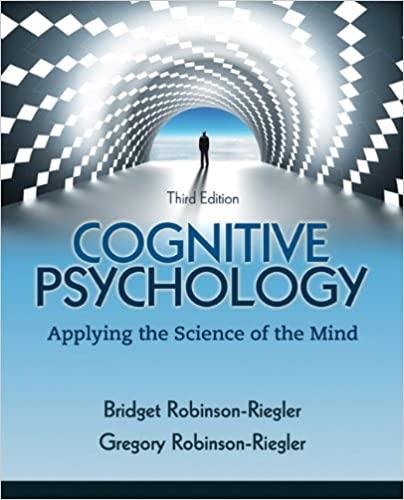Question
We were to choose a case -I chose the case here below- this will be fve to sven pages long , ive also attached references
We were to choose a case -I chose the case here below- this will be fve to sven pages long, ive also attached references that I NEED TO USE SPECIFICS for the case that was provided to us. This is under "A common sense Approach to Business Ethics" and its Analyzing an Ethical Dilemma in class PSYCH/639: Ethics And Professional Skills In I-o Psychology-- I POSTED THIS QUESTIONS BEFORE BUT IT DIDNT HAVE ANYTHING SPECIFIC THAT I COULD USE -
It's hard to be a start-up. To get funding from major venture capitalists with deep pockets requires having a good story. NOTHAM Foods's story had two parts that the company's charismatic founder Daniel Certech regularly pitched to investors. The first was about its rapid growth in sales. The second dealt with the scientific advances it was making in the use of plant proteins that could be used to feed the 9 billion people who would inhabit the planet by 2050. However, Jane Ireland, a newly hired accounting employee, noticed that to boost sales the company was systematically buying back its own inventory, expensing the buybacks as marketing costs under the category of Inventory Consumed for Samples and Internal Testing. This practice did not seem right, though she did not know if it was illegal. In the company lunchroom, she remarked to Anne Spinoza, a colleague and a friend who did research on plant proteins, "It's just a matter of time when there will be consequences. Investors will figure this out when they scrutinize our accounting. They could pull financing and we would not have the cash to keep going. What if they thought they were duped and brought a fraud case against us?" Anne replied, "You know, the yellow pea protein project on which I am working hasn't yielded any results, but Daniel keeps touting it as a winner." What should Jane and Anne do?
I. Situate yourselfas an I/O psychologist for the company by summarizing your role as advisor to leadership, sales, or human resources.
II. Use the frameworkoutlined in the text:
- Identify the issue.
- Establish the facts.
- Identify options.
- Assess consequences for each option, including doing nothing.
- Use the Table of Pros and Cons.
- Apply the principles.
- Answer the following:
- Can I defend these principles to the company's board of directors?
- Can I explain them in court?
- Can I explain them to the media?
- Can I explain them to my fellow workers?
- Can I explain them to my family?
- Following these principles, how will I feel about this decision a year from now?
- Would this decision seem right 20 years from now when someone writes my biography or the history of my organization?
- Describe your course of action.
- Outline the short-term fix to the long-term solution.
- What are the lessons learned?
1. Mintzberg, H., Raisinghani, D., & Thort, A. (1976). The structure of "unstructured" decision processes. Administrative Science Quarterly, 21, 246-275.
2. Cyert, R. M., & March, J. G. (1963). A behavioral theory of the firm. Englewood Ciiffs, N.J.: Prentice-Hall; Cyert, R. M., Simon, H. A., & Trow, D. B. (1956). Observation of a business decision. Journal of Business, 29, 237-248.
3. Simon, H. A. (1957). Models of man: Social and rational (1st ed.). New York, NY: Wiley.
4. This video depicts a variation on Simons and Chabris's "invisible gorilla" experiment. Chabris, C., & Simons, D. (2011). The invisible gorilla: How our intuitions deceive us. New York, NY: Harmony.
5. Haidt, J. (2012). The righteous mind: Why good people are divided by politics and religion. New York, NY: Vintage Books.
6. Willcox, W. B. (Ed.). (1975). The papers of Benjamin Franklin: Vol. 19. January 1 through December 31, 1772 (pp. 299-300). New Haven, CT: Yale University Press.
7. Weick, K. E. (1993). The collapse of sensemaking in organizations: The Mann Gulch disaster. Administrative Science Quarterly, 38(4), 628-652.
8. Hammond, K. (1996). Human judgment and social policy: Irreducible uncertainty, inevitable error, unavoidable injustice. Oxford, UK: Oxford University Press.
9. Simon, H. A., & March, J. (1976). Administrative behavior. New York, NY: Free Press.
10. For Peirce's pragmatic maxim, see Peirce, C. S. (1878). How to make our ideas clear. Popular Science Monthly, 12, 286-302.
11. Pratt, M. G. (2000). The good, the bad and the ambivalent: Managing identification among Amway distributors. Administrative Science Quarterly, 45(3), 456-493.
12. Festinger, L. (1962). A theory of cognitive dissonance. Palo Alto, CA: Stanford University Press.
13. Goffman, E. (1974). Frame analysis: An essay on the organization of experience. Cambridge, MA: Harvard University Press.
14. Wason, P. C. (1960). On the failure to eliminate hypotheses in a conceptual task. Quarterly Journal of Experimental Psychology, 12(3), 129-140.
15. Heider, F. (1958). The psychology of interpersonal relations. New York, NY: Wiley.
16. Merton, R. K. (1936). The unanticipated consequences of purposive social action. American Sociological Review, 1(6), 904.
17. Williams, B., & Smart, J. J. C. (1973). Utilitarianism: For and against. Cambridge, UK: Cambridge University Press.
18. See Mintzberg et al. (1976).
19. Staw, B. M. (1976). Knee-deep in the big muddy: a study of escalating commitment to a chosen course of action. Organizational Behavior and Human Performance, 16(1), 27-44.
20. McAdam, D., Tarrow, S., & Tilly, C. (2001). Dynamics of contention. Cambridge, UK: Cambridge University Press.
21. Nisbett, R. E. (2015). Mindware: Tools for smart thinking. New York, NY: Farrar, Straus & Giroux.
Step by Step Solution
There are 3 Steps involved in it
Step: 1

Get Instant Access to Expert-Tailored Solutions
See step-by-step solutions with expert insights and AI powered tools for academic success
Step: 2

Step: 3

Ace Your Homework with AI
Get the answers you need in no time with our AI-driven, step-by-step assistance
Get Started


